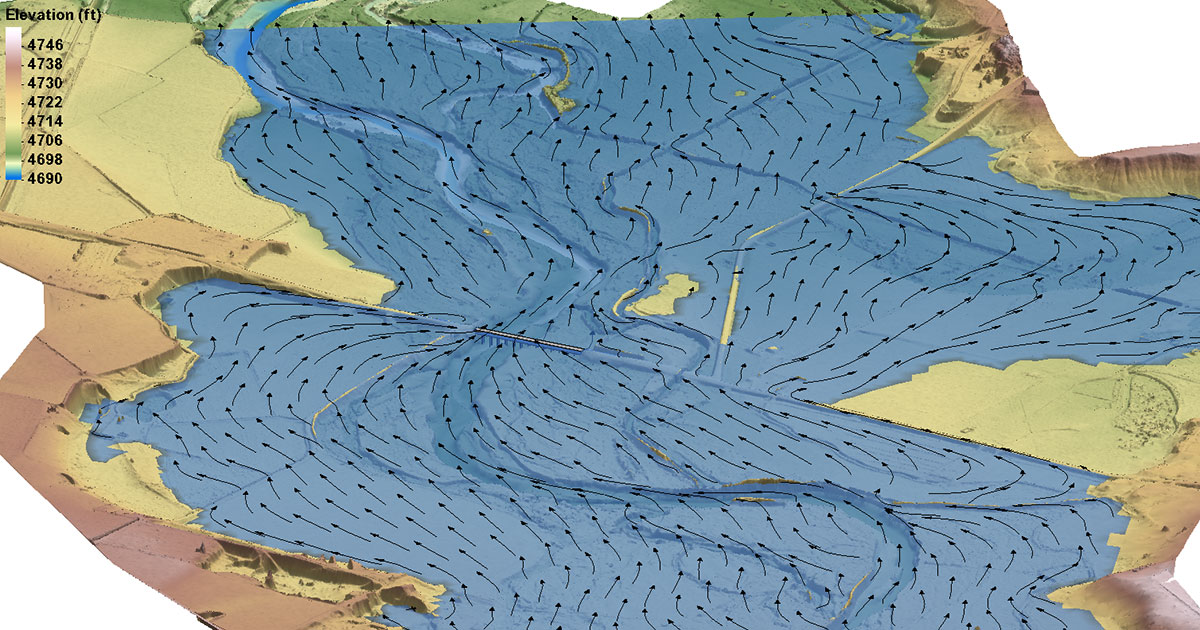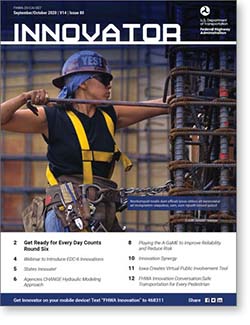September 17, 2020
Innovation of the Month:
Collaborative Hydraulics: Advancing to the Next Generation of Engineering (CHANGE)
Last week, we discussed the importance of model reviews for the hydraulic modeling process which can help agencies assess flow conditions at roadway crossings more accurately.
Swiftly moving water at roadway crossings can cause bridge scour–the removal of sand, gravel, or other sediment from around bridge piers or abutments, which can compromise the integrity of a structure.
With one-dimensional modeling, flow directions are defined by the user during model setup. In a 2D model, flow directions are computed by the model at every element in the mesh. This means multiple flow paths and flow splits are more accurately represented in a 2D model.

With this improved representation of the flow paths and flow distribution at a crossing, engineers can develop better estimates of scour at each bridge component. Furthermore, since the flow direction is computed in a 2D model, the angle of attack at bridge piers can be directly assessed rather that estimated.
To support use of 2D model results for bridge scour evaluation, FHWA has added specific scour tools in the SMS software interface for the SRH-2D model. With these tools, averaged hydraulic parameters from specified locations can be computed and used in the FHWA Hydraulic Toolbox Bridge Scour Calculators, or other custom scour spreadsheets developed by users.
For more information on these new bridge scour tools, please explore the following links:
To learn more, please contact Scott Hogan or Laura Girard, Collaborative Hydraulics: Advancing to the Next Generation of Engineering (CHANGE) team co-leads.
Get Ready for Every Day Counts Round Six!
Federal Highway Administrator Nicole R. Nason will be hosting an Executive Session for State CEOs and other transportation industry partners and stakeholders to announce the next round of Every Day Counts innovations on September 23, 2020.
The EDC-6 innovations feature initiatives to increase engagement with the people who build and use the transportation infrastructure, new applications of products to save money on preserving and repairing bridges and roads, and processes to save time on project delivery and incident management. Register now for the web conference to learn how the EDC-6 innovations can help agencies increase engagement, save money, and save time.
Keep reading EDC News for the latest information on the launch of EDC-6!
STEP Studio: Interactive Toolbox for Improving Pedestrian Crossing Safety
In July 2020, FHWA released the STEP Studio: a toolbox for selecting and implementing countermeasures for improving pedestrian crossing safety. STEP Studio is a visual and interactive resource that follows the steps outlined in the FHWA Guide for Improving Pedestrian Safety at Uncontrolled Crossing Locations to identify potential countermeasures for a variety of contexts. STEP Studio links the user to case studies, research studies, videos and FHWA guidance that go deeper into the benefits and design considerations of the “spectacular seven” STEP countermeasures.
If you would like more information on the STEP program, contact Becky Crowe with FHWA's Office of Safety or Peter Eun with the FHWA Resource Center.
Did You Catch the Last Innovator?
The September/October issue of Innovator is now available, accessible from any device! This new and improved format will optimize your reading experience, whether you access it from your mobile phone, tablet, or computer.
In this issue:
- Get Ready for Every Day Counts Round Six
- Agencies CHANGE Hydraulic Modeling Approach
- Playing the A-GaME to Improve Reliability and Reduce Risk
- Iowa Creates Virtual Public Involvement Tool
- And more...
Comments? Questions? We'd love your feedback! Drop us a line and let us know what you think.
Read past issues and sign up to receive Innovator by email here, or text "FHWA Innovation" to 468311 to get Innovator on your smartphone.
About EDC
Every Day Counts, a State-based program of the Federal Highway Administration’s Center for Accelerating Innovation, works with State, local, and private sector partners to encourage the adoption of proven technologies and innovations to shorten and enhance project delivery.



